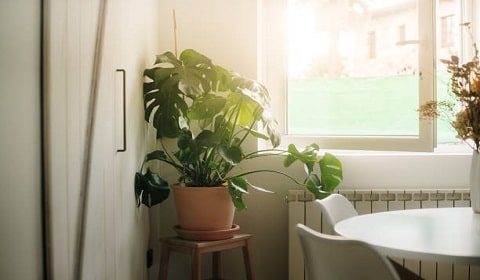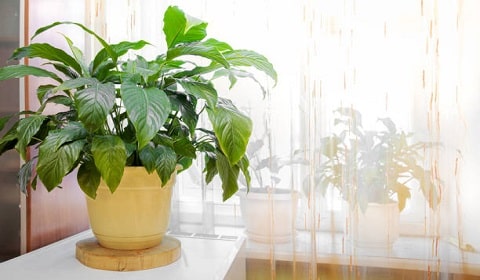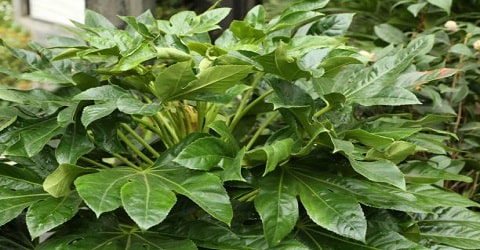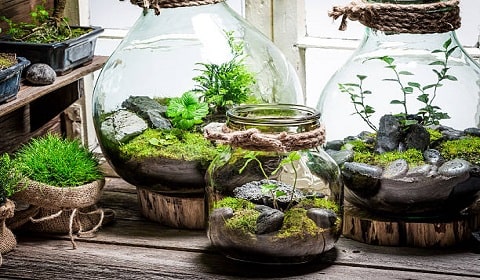Indoor plants for east-facing windows flourish in direct morning sunlight and bright indirect daylight, fostering strong, healthy growth. Positioned strategically on east-facing windows or doors, these plants flourish in various containers like pots, hanging baskets, window boxes, windowsills, and shelves.
Their ideal placement harnesses the natural light to enhance their vitality, making them a vibrant addition to any indoor space. With proper care and attention, these plants transform their environment, adding a touch of natural beauty while benefiting from the optimal conditions provided by the eastern exposure.
Best Indoor Plants for East-Facing Windows
East-facing windows provide an ideal environment for a variety of indoor plants, offering a balance of bright, indirect sunlight and cooler temperatures. Whether you’re a seasoned plant enthusiast or a beginner looking to green up your living space, selecting the right plants for your east-facing window can significantly enhance the aesthetics and air quality of your home.
In this guide, we’ll explore a diverse selection of indoor plants suitable for east-facing windows, including their botanical names, leaf color varieties, light and water requirements, mature sizes, and maintenance difficulty levels.
Table of Contents
1. Japanese Aralia
Botanical Name: Fatsia japonica
Leaf Color Varieties: Typically glossy dark green, sometimes variegated with creamy white or yellow.
Light Requirement: Prefers bright, indirect light but can tolerate some shade.
Water Requirement: Keep soil consistently moist but not waterlogged. Allow the top inch of soil to dry out between waterings.
Mature Size: Can reach heights of 6 to 10 feet with a similar spread.
Difficulty: Relatively easy to care for, but may drop leaves if environmental conditions are not ideal.
It is known for its striking foliage and architectural form, Japanese Aralia adds a touch of elegance to indoor spaces. Its glossy, deeply lobed leaves bring a sense of drama and sophistication. Japanese Aralia plants bloom as indoor plants for east-facing windows, adding lushness to any room.
Read More: Best Low-Light Indoor Plants
2. Areca Palm
Botanical Name: Dypsis lutescens
Leaf Color Varieties: Typically bright green, with multiple stems and feathery fronds.
Light Requirement: Prefers bright, indirect light but can tolerate some direct sunlight.
Water Requirement: Keep soil evenly moist during the growing season, but allow the top inch of soil to dry out between waterings in winter.
Mature Size: Can grow up to 6 to 10 feet tall indoors, with a spread of 3 to 5 feet.
Difficulty: Moderate care required, needs regular watering and occasional fertilization.
With its graceful fronds and tropical charm, the Areca Palm instantly transforms interiors into tranquil oases. Its feathery foliage creates a lush, jungle-like ambiance, making it a popular choice for indoor landscaping. It flourishes as indoor plants for east-facing windows, bringing a slice of paradise indoors.
Read More: Best Indoor Hanging Plants
3. Swiss Cheese Plant
Botanical Name: Monstera deliciosa
Leaf Color Varieties: Deep green, with distinct splits and holes giving it a “Swiss cheese” appearance.
Light Requirement: Prefers bright, indirect light but can tolerate some shade.
Water Requirement: Keep soil lightly moist during the growing season and allow the top inch of soil to dry out between waterings in winter.
Mature Size: Can grow up to 6 to 10 feet tall indoors, with a spread of 3 to 5 feet.
Difficulty: Fairly easy to care for, but may need support for its climbing habit as it matures.
Characterized by its large, fenestrated leaves, the Swiss Cheese Plant makes a bold statement in any indoor setting. Its unique foliage adds texture and visual interest, making it a favorite among plant enthusiasts. This plant flowers as indoor plants for east-facing windows, enhancing spaces with its tropical flair.

4. Peace Lily
Botanical Name: Spathiphyllum spp.
Leaf Color Varieties: Dark green, with elegant white flowers emerging from a white or green spadix.
Light Requirement: Prefers medium to low indirect light but can tolerate some shade.
Water Requirement: Keep soil consistently moist but not waterlogged. It’s sensitive to overwatering.
Mature Size: Can reach heights of 1 to 4 feet tall, with a spread of 1 to 2 feet.
Difficulty: Relatively easy to care for, but prone to root rot if overwatered.
Renowned for its elegant white blooms and glossy foliage, the Peace Lily exudes serenity and beauty. Its lush green leaves provide a stunning backdrop for the striking flowers, making it a popular choice for indoor décor. This plant serves as indoor plants for east-facing windows, bringing peace and tranquility to any space.
Read More: Best Bedroom Plants
5. Polka Dot Plant
Botanical Name: Hypoestes phyllostachya
Leaf Color Varieties: Variegated with pink, red, white, or purple spots on green leaves.
Light Requirement: Prefers bright, indirect light but can tolerate some shade.
Water Requirement: Keep soil consistently moist but not waterlogged.
Mature Size: Typically grows up to 6 to 12 inches tall with a similar spread.
Difficulty: Easy to care for, but requires regular pruning to maintain bushy growth.
Admired for its colorful foliage adorned with whimsical polka dots, the Polka Dot Plant adds a playful touch to indoor gardens. Its vibrant leaves come in various shades, adding a splash of color to interiors. This plant thrives as indoor plants for east-facing windows, brightening up any room with its charm.
6. Hoya
Botanical Name: Hoya spp.
Leaf Color Varieties: Green, sometimes variegated with white, pink, or yellow.
Light Requirement: Prefers bright, indirect light but can tolerate some shade.
Water Requirement: Allow the top inch of soil to dry out between waterings.
Mature Size: Varies depending on the species, can range from trailing vines to compact shrubs.
Difficulty: Generally easy to care for, but may be slow-growing and require occasional pruning.
Known for its unique waxy flowers and trailing vines, Hoya is a beloved choice for hanging baskets and shelves. Its blooms exude a sweet fragrance, adding to its allure. This plant serves as indoor plants for east-facing windows, cascading gracefully and infusing spaces with natural beauty.
7. Umbrella Tree
Botanical Name: Schefflera actinophylla or Schefflera arboricola
Leaf Color Varieties: Typically dark green, sometimes variegated with yellow or cream.
Light Requirement: Prefers bright, indirect light but can tolerate some shade.
Water Requirement: Allow the top inch of soil to dry out between waterings.
Mature Size: Can grow up to 6 to 15 feet tall indoors, with a spread of 3 to 6 feet.
Difficulty: Moderate care required, may drop leaves if conditions aren’t ideal.
With its graceful, umbrella-like foliage and slender stems, the Umbrella Tree makes a striking addition to indoor landscapes. Its lush green leaves create a canopy of shade, bringing a touch of the tropics indoors. This plant expands as indoor plants for east-facing windows, adding a touch of elegance to any room.
Read More: Small Garden Design Ideas
8. Calathea
Botanical Name: Calathea spp.
Leaf Color Varieties: Various patterns and colors including green, purple, pink, and white.
Light Requirement: Prefers bright, indirect light but can tolerate some shade.
Water Requirement: Keep soil consistently moist but not waterlogged, and provide high humidity.
Mature Size: Typically grows up to 1 to 2 feet tall with a similar spread.
Difficulty: Moderate care required, sensitive to dry air and cold drafts.
Revered for its intricate leaf patterns and vibrant colors, Calathea adds a tropical flair to indoor spaces. Its striking foliage undergoes fascinating movements, earning it the nickname “prayer plant.” This plant flourishes as indoor plants for east-facing windows, captivating onlookers with its beauty and charm.
9. Croton
Botanical Name: Codiaeum variegatum
Leaf Color Varieties: Variegated with bright colors including red, orange, yellow, and green.
Light Requirement: Prefers bright, indirect light but can tolerate some direct sunlight.
Water Requirement: Keep soil evenly moist during the growing season, and reduce watering in winter.
Mature Size: Can reach heights of 3 to 6 feet tall indoors, with a spread of 2 to 4 feet.
Difficulty: Moderate care required, may drop leaves if conditions aren’t ideal.
Celebrated for its bold, multicolored leaves, the Croton injects a dose of vibrancy into indoor settings. Its fiery hues and unique foliage patterns make it a standout choice for decorative purposes. This plant thrives as indoor plants for east-facing windows, infusing spaces with warmth and personality.
10. Aluminum Plant
Botanical Name: Pilea cadierei
Leaf Color Varieties: Dark green leaves with silvery markings resembling aluminum foil.
Light Requirement: Prefers bright, indirect light but can tolerate some shade.
Water Requirement: Keep soil consistently moist but not waterlogged.
Mature Size: Typically grows up to 6 to 12 inches tall with a similar spread.
Difficulty: Fairly easy to care for, but may be susceptible to pests like spider mites.
Recognized for its silvery, metallic sheen and delicate foliage, the Aluminum Plant adds a touch of elegance to indoor gardens. Its shimmering leaves reflect light beautifully, creating a captivating display. This plant serves as indoor plants for east-facing windows, lending a contemporary feel to interiors.
11. Nerve Plant
Botanical Name: Fittonia spp.
Leaf Color Varieties: Variegated with red, pink, white, or silver veins on dark green leaves.
Light Requirement: Prefers bright, indirect light but can tolerate some shade.
Water Requirement: Keep soil consistently moist but not waterlogged.
Mature Size: Typically grows up to 6 to 12 inches tall with a similar spread.
Difficulty: Requires high humidity and regular watering, may wilt if soil dries out.
With its intricate veining and vibrant hues, the Nerve Plant adds a pop of color and texture to indoor spaces. Its striking foliage makes it a standout choice for terrariums and dish gardens. This plant booms as indoor plants for east-facing windows, captivating observers with its beauty.
12. Boston Fern
Botanical Name: Nephrolepis exaltata
Leaf Color Varieties: Bright green fronds with a feathery appearance.
Light Requirement: Prefers bright, indirect light but can tolerate some shade.
Water Requirement: Keep soil consistently moist but not waterlogged.
Mature Size: Can reach heights of 1 to 3 feet tall with a spread of 1 to 3 feet.
Difficulty: Requires high humidity and regular watering, may shed leaves if conditions are too dry.
Known for its lush, cascading fronds and graceful arching habit, the Boston Fern brings a sense of freshness and vitality to indoor environments. Its feathery foliage adds a touch of softness and elegance to any room. This plant flourishes as indoor plants for east-facing windows, enlivening spaces with its verdant charm.
13. Clivia
Botanical Name: Clivia spp.
Leaf Color Varieties: Dark green leaves, occasionally variegated with yellow or cream.
Light Requirement: Prefers bright, indirect light but can tolerate some shade.
Water Requirement: Allow the top inch of soil to dry out between waterings.
Mature Size: Typically grows up to 1 to 2 feet tall with a similar spread.
Difficulty: Fairly easy to care for, but slow-growing and may not flower if conditions aren’t ideal.
Admired for its bold clusters of trumpet-shaped blooms and glossy foliage, Clivia adds a touch of exotic beauty to indoor settings. Its vibrant flowers range from fiery oranges to soft yellows, brightening up interiors. This plant serves as indoor plants for east-facing windows, creating a captivating focal point.
14. Prayer Plant
Botanical Name: Maranta leuconeura
Leaf Color Varieties: Variegated with green, red, and white markings.
Light Requirement: Prefers bright, indirect light but can tolerate some shade.
Water Requirement: Keep soil consistently moist but not waterlogged.
Mature Size: Typically grows up to 6 to 12 inches tall with a similar spread.
Difficulty: Requires high humidity and regular watering, may suffer from leaf curl if conditions aren’t ideal.
Named for its fascinating leaf movements resembling hands in prayer, the Prayer Plant adds an element of intrigue to indoor gardens. Its colorful foliage and unique patterns make it a standout choice for décor. This plant thrives as indoor plants for east-facing windows, captivating viewers with its mesmerizing performance.
15. Orchids
Botanical Name: Orchidaceae family, various genera (e.g., Phalaenopsis, Dendrobium)
Leaf Color Varieties: Green, with various patterns and colors depending on the species and hybrid.
Light Requirement: Typically prefers bright, indirect light but can vary depending on the species.
Water Requirement: Varies depending on the species, generally requires well-draining media and moderate watering.
Mature Size: Varies widely depending on the species, from miniature to large plants.
Difficulty: Can vary depending on the species, some are relatively easy to care for while others require more specialized care.
Revered for their exquisite blooms and graceful demeanor, Orchids add a touch of luxury and elegance to indoor spaces. Their intricate flowers come in a myriad of colors and shapes, creating a captivating display. This plant serves as indoor plants for east-facing windows, elevating interiors with its beauty.
16. Anthurium
Botanical Name: Anthurium spp.
Leaf Color Varieties: Dark green, with brightly colored spathes (modified leaves) in shades of red, pink, or white.
Light Requirement: Prefers bright, indirect light but can tolerate some shade.
Water Requirement: Keep soil consistently moist but not waterlogged.
Mature Size: Typically grows up to 1 to 3 feet tall with a similar spread.
Difficulty: Moderate care required, may benefit from regular misting to increase humidity.
Renowned for its heart-shaped blooms and glossy foliage, Anthurium adds a tropical flair to indoor settings. Its vibrant flowers come in various shades, adding a pop of color to interiors. This plant flourishes as indoor plants for east-facing windows, infusing spaces with romance and charm.
17. Jade Plant
Botanical Name: Crassula ovata
Leaf Color Varieties: Thick, oval-shaped leaves that are typically jade green but can turn reddish at the tips under stress.
Light Requirement: Prefers bright, indirect light but can tolerate some direct sunlight.
Water Requirement: Allow the top inch of soil to dry out between waterings.
Mature Size: Can grow up to 1 to 3 feet tall indoors, with a similar spread.
Difficulty: Relatively easy to care for, but prone to overwatering which can cause root rot.
Loved for its resilient nature and symbolic significance, the Jade Plant is a popular choice for indoor décor. Its fleshy, jade-green leaves symbolize prosperity and good luck, making it a beloved addition to homes. This plant serves as indoor plants for east-facing windows, bringing positive energy and vitality indoors.
18. Purple Shamrock
Botanical Name: Oxalis triangularis
Leaf Color Varieties: Triangular-shaped leaves in shades of purple, sometimes with a silvery sheen on the undersides.
Light Requirement: Prefers bright, indirect light but can tolerate some shade.
Water Requirement: Keep soil consistently moist but not waterlogged.
Mature Size: Typically grows up to 6 to 12 inches tall with a similar spread.
Difficulty: Easy to care for, but may go dormant and lose leaves periodically.
Admired for its triangular, purple-hued leaves and delicate appearance, the Purple Shamrock adds a touch of whimsy to indoor gardens. Its charming foliage and compact growth habit make it a delightful choice for décor. This plant thrives as indoor plants for east-facing windows, enchanting observers with its beauty.
19. Watermelon Peperomia
Botanical Name: Peperomia argyreia
Leaf Color Varieties: Dark green leaves with silver stripes resembling the rind of a watermelon.
Light Requirement: Prefers bright, indirect light but can tolerate some shade.
Water Requirement: Allow the top inch of soil to dry out between waterings.
Mature Size: Typically grows up to 6 to 8 inches tall with a similar spread.
Difficulty: Easy to care for, but prone to root rot if overwatered.
Recognized for its striking foliage resembling watermelon rinds, the Watermelon Peperomia adds a playful touch to indoor landscapes. Its succulent-like leaves and compact growth habit make it a low-maintenance choice for décor. This plant serves as indoor plants for east-facing windows, adding a splash of color to interiors.
20. Heartleaf Philodendron
Botanical Name: Philodendron hederaceum
Leaf Color Varieties: Dark green, heart-shaped leaves, sometimes variegated with white or yellow.
Light Requirement: Prefers bright, indirect light but can tolerate some shade.
Water Requirement: Allow the top inch of soil to dry out between waterings.
Mature Size: Can grow up to 6 to 10 feet tall indoors, with a spread of 2 to 4 feet.
Difficulty: Relatively easy to care for, but may benefit from occasional pruning to control growth.
With its heart-shaped leaves and trailing vines, the Heartleaf Philodendron adds a touch of romance to indoor settings. Its lush foliage and easy-care nature make it a popular choice for hanging baskets and shelves. This plant thrives as indoor plants for east-facing windows, enhancing spaces with its charm.
21. English Ivy
Botanical Name: Hedera helix
Leaf Color Varieties: Dark green, lobed leaves, sometimes variegated with white or yellow.
Light Requirement: Prefers bright, indirect light but can tolerate some shade.
Water Requirement: Keep soil consistently moist but not waterlogged.
Mature Size: Can grow as a trailing vine or climb vertically, reaching lengths of several feet.
Difficulty: Moderate care required, may benefit from regular pruning to prevent leggy growth and maintain appearance.
Revered for its trailing vines and evergreen foliage, English Ivy adds a touch of classic elegance to indoor gardens. Its vigorous growth habit and ability to climb make it a versatile choice for décor. This plant serves as indoor plants for east-facing windows, bringing a sense of lushness and sophistication to interiors.
Bottom Line
Incorporating indoor plants into your east-facing windows can transform your living space into a vibrant and inviting oasis. By understanding the unique characteristics and care requirements of each plant species, you can create a thriving indoor garden that not only enhances your home’s aesthetic appeal but also promotes a healthier and happier living environment. Whether you’re drawn to lush foliage, colorful blooms, or unique textures, there’s a perfect plant for every east-facing window.




